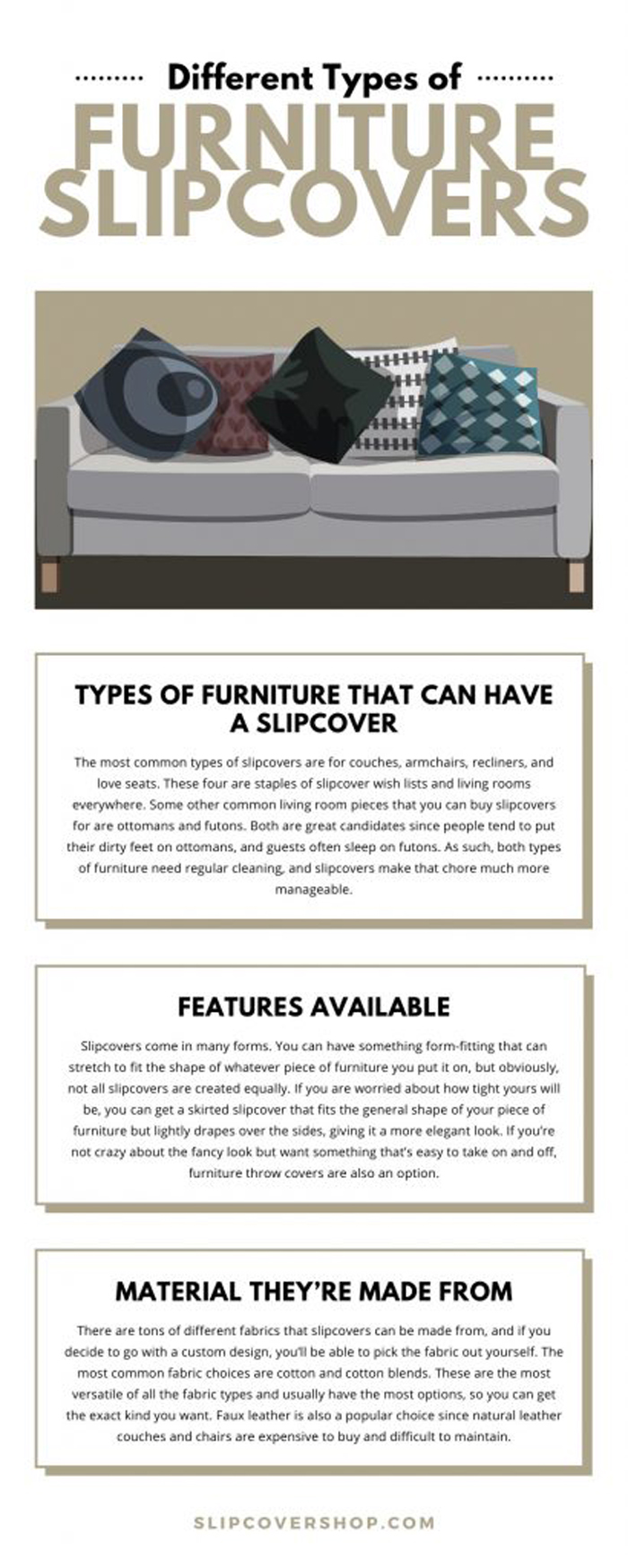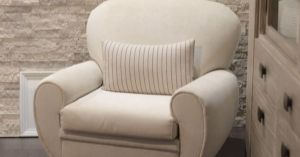Some people want slipcovers to spruce up their old furniture. Others want them to make cleaning a much simpler task. Regardless of your reasoning, anyone who is currently in the market for slipcovers knows that the number of choices can be a bit overwhelming. If that accurately describes how you’re feeling about your search at the moment, it’s time to put your mind at ease. We are here to go over all of the different types of furniture slipcovers that you will likely find during your browsing. Hopefully, this list will help you better figure out what you’re looking for in your household.
Types of Furniture That Can Have a Slipcover
When you first decide to get slipcovers, the most important factor to consider is which pieces of furniture you will get them for. Most of you have probably already made this decision, but there might be some choices that you didn’t realize, so we will go over all of them. The most common types of slipcovers are for couches, armchairs, recliners, and love seats. These four are staples of slipcover wish lists and living rooms everywhere. Some other common living room pieces that you can buy slipcovers for are ottomans and futons. Both are great candidates since people tend to put their dirty feet on ottomans, and guests often sleep on futons. As such, both types of furniture need regular cleaning, and slipcovers make that chore much more manageable. The other main area that benefits from slipcovers is the outdoors. Some pieces of outdoor furniture don’t withstand the elements as well as they should, so buying weather-resistant slipcovers is the best way to protect them. There are still a few more options that most people forget. If food spills are your primary concern, then slipcovers for your dining room chairs and stools will be the types you’ll need. If you’re simply looking for something fancy in the bedroom, then maybe you will want to get a slipcover for your window seat or the headboard on your bed.
Features Available
Slipcovers come in many forms. You can have something form-fitting that can stretch to fit the shape of whatever piece of furniture you put it on, but obviously, not all slipcovers are created equally. If you are worried about how tight yours will be, you can get a skirted slipcover that fits the general shape of your piece of furniture but lightly drapes over the sides, giving it a more elegant look. If you’re not crazy about the fancy look but want something that’s easy to take on and off, furniture throw covers are also an option. For those of you who want something that’s the best of both worlds, there are looser-fitting ones that have an elastic grip at the bottom. That way, they don’t have a fit that’s too snug, but still aren’t sliding around too much when you sit on them. No matter how you cut it, the best solution, in the end, is to order custom-made furniture covers, which we specialize in. When you start the process, we ask you for all of the dimensions and a few pictures of the piece of furniture for which you want a slipcover. Then, we custom make them so they will fit your piece perfectly. This method truly makes all of the previous choices look obsolete. There are still a couple more choices in terms of functionality, though. If you want to ensure that your furniture will stay safe from food spills, then you should get slipcovers that come with extra protection. However, if the type of dangers your furniture faces come from pets, pet-friendly ones can withstand sharp claws and bad smells.
Material They’re Made From
There are tons of different fabrics that slipcovers can be made from, and if you decide to go with a custom design, you’ll be able to pick the fabric out yourself. The most common fabric choices are cotton and cotton blends. These are the most versatile of all the fabric types and usually have the most options, so you can get the exact kind you want. Faux leather is also a popular choice since natural leather couches and chairs are expensive to buy and difficult to maintain. If your goal is to boost the appeal of your current furniture, though, then velvet, linen, and suede are the materials you’ll want. All of these are quite luxurious but challenging to keep looking nice, so they are best for furniture that isn’t heavily used. On the other hand, if you’re more into practicality, then you’ll want to check out a polyester or microfiber slipcover. The former is best for cleaning up messes after the fact, and the latter is best for preventing them from spreading. Both are great for families who like to sit in the living room and watch TV while eating.
How They Attach
Although we’ve already mentioned that there is one type of slipcover that utilizes elastic to stay in place, that’s not the only way these covers remain attached to your furniture. Other than elastic, your slipcovers could have ties in the back holding them on, fancy-looking hook and loop fasteners, or easy to open and close zippers. Of course, each of these has its own lists of pros and cons, but what it really comes down to in the end is your personal preference.
How You Clean Them
While it’s fun to go over all of the different types of furniture slipcovers available, there’s one key feature that some people forget to consider when buying theirs—how to clean them when they get dirty. A lot of people assume that you can throw them into the washer since they are easily removable, but that’s not always the case. The materials they are made of, like faux leather, for example, is one of the biggest determining factors here, but sometimes there are other features that affect how you should clean them. Before going through with a purchase, check the fine print to see if they are machine washable, dry-clean only, or better for hand washing and spot cleaning. It’s up to you to make sure you get the type that will be the best fit for you and your family. 

